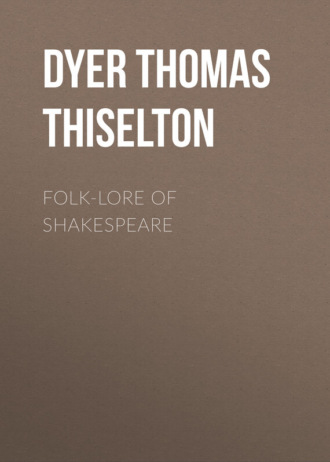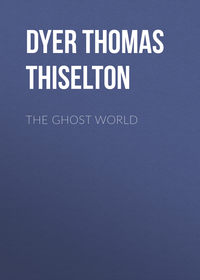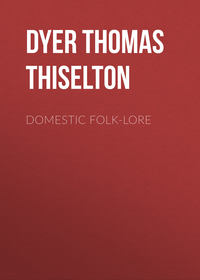 полная версия
полная версияFolk-lore of Shakespeare
408
“Illustrations of Shakespeare,” p. 183.
409
These dogs were kept for baiting bears, when that amusement was in vogue, and “from their terrific howling they are occasionally introduced to heighten the horror of the picture.” Nares’s “Glossary,” vol. i. p. 50.
410
See Kelly’s “Indo-European Folk-Lore,” p. 109.
411
Henderson’s “Folk-Lore of the Northern Counties,” p. 48.
412
See “English Folk-Lore,” p. 101.
413
See Hardwick’s “Traditions, Superstitions, and Folk-Lore,” p. 171.
414
“Myths and Mythmakers,” 1873, p. 36.
415
“Nares’s Glossary,” vol. i. p. 218.
416
For the various versions of this myth consult Baring-Gould’s “Curious Myths of the Middle Ages,” 1877, pp. 266-316.
417
Cf. “Troilus and Cressida,” v. 8; “Midsummer-Night’s Dream,” iii. 2.
418
Singer’s “Shakespeare,” vol. x. p. 363.
419
“Demonology and Devil-Lore,” 1880, vol. i. p. 383.
420
The dragon formerly constituted a part of the morris-dance.
421
Sir Thomas Browne’s Works, 1852, vol. i. pp. 220-232.
422
Edited by Simon Wilkin, 1852, vol. i. p. 226.
423
See Pliny’s “Natural History,” bk. viii.
424
Staunton’s “Shakespeare,” 1864, vol. ii. p. 367; Nares’s “Glossary,” vol. i. p. 331.
425
Singer’s “Shakespeare,” vol. ix. p. 75.
426
See Wright’s Notes to “The Tempest,” 1875, p. 94.
427
Conway’s “Demonology and Devil-Lore,” 1880, vol. i. p. 122.
428
Warburton on “Romeo and Juliet,” i. 4.
429
Dyce’s “Glossary,” p. 104.
430
See Douce’s “Illustrations of Shakespeare,” p. 106; Nares’s “Glossary,” vol. ii. p. 830.
431
“Glossary,” p. 412.
432
See Strutt’s “Sports and Pastimes,” p. 48.
433
Singer’s “Shakespeare,” 1875, vol. vii. p. 277.
434
“Natural History,” bk. viii. c. 19.
435
“Arcana Microcosmi,” p. 151.
436
1852, vol. i. pp. 312-315.
437
See Nares’s “Glossary,” vol. ii. p. 577; Singer’s “Shakespeare,” vol. v. p. 77.
438
Halliwell-Phillipps’s “Handbook Index to Shakespeare,” 1866, p. 331.
439
Forby’s “Vocabulary of East Anglia,” vol. ii. p. 222.
440
See Staunton’s “Shakespeare,” vol. i. p. 278.
441
Cf. “King Lear,” iv. 6.
442
See Nares’s “Glossary,” vol. ii. p. 673.
443
Ibid., vol. ii. p. 189.
444
See D’Israeli’s “Curiosities of Literature,” vol. iii. p. 78.
445
“The strange phrase and the superstition that arose out of it seem to have been produced by a mistranslation, by the English-speaking population of a considerable portion of Ireland, of two Celtic or Gaelic words, ran, to roar, to shriek, to bellow, to make a great noise on a wind instrument; and rann, to versify, to rhyme. It is well known that rats are scared by any great and persistent noise in the house which they infest. The Saxon English, as well as Saxon Irish, of Shakespeare’s time, confounding rann, a rhyme, with ran, a roar, fell into the error which led to the English phrase as used by Shakespeare.” —Antiquarian Magazine and Bibliographer, 1882, vol. ii. p. 9. “On Some Obscure Words and Celtic Phrases in Shakespeare,” by Charles Mackay.
446
See “English Folk-Lore,” 1878, p. 120.
447
See Brewer’s “Dictionary of Phrase and Fable,” p. 922.
448
See Brand’s “Pop. Antiq.,” 1849, vol. iii. p. 283.
449
Aconitum napellus, Wolf’s-bane or Monk’s-hood.
450
“Miseros fallunt aconita legentis” (Georgics, bk. ii. l. 152).
451
See Ellacombe’s “Plant-Lore of Shakespeare,” 1878, pp. 7, 8.
452
Dr. Prior’s “Popular Names of British Plants,” 1870, pp. 1, 2.
453
Phillips, “Flora Historica,” 1829, vol. ii. pp. 122, 128.
454
“Plant-Lore of Shakespeare,” pp. 10, 11.
455
Phillips, “Flora Historica,” 1829, vol. i. p. 104.
456
Ellacombe’s “Plant-Lore of Shakespeare,” p. 13.
457
Dyce’s “Glossary to Shakespeare,” p. 15.
458
See Nares’s “Glossary,” vol. ii. p. 29; probably synonymous with the term “apple-Squire,” which formerly signified a pimp.
459
Forby, in his “Vocabulary of East Anglia,” says of this apple, “we retain the name, but whether we mean the same variety of fruit which was so called in Shakespeare’s time, it is not possible to ascertain.”
460
Ellacombe’s “Plant-Lore of Shakespeare,” p. 16; Dyce’s “Glossary,” p. 430; Nares’s “Glossary,” vol. i. p. 81; Coles’s “Latin and English Dictionary.” “A bitter-suete [apple] – Amari-mellum.”
461
See chapter xi., Customs connected with the Calendar.
462
See chapter on Customs connected with Birth and Baptism.
463
Edited by Dyce, 1861, p. 446. Many fanciful derivations for this word have been thought of, but it was no doubt named from its smoothness and softness, resembling the wool of lambs.
464
Dr. Prior’s “Popular Names of British Plants,” 1870, p. 50.
465
Note on Jonson’s Works, vol. iv. p. 24.
466
Dyce’s “Glossary,” p. 242.
467
Quoted by Nares’s “Glossary,” vol. ii. p. 662.
468
“Plant-Lore of Shakespeare,” p. 16.
469
“Theatrum Botanicum,” 1640.
470
“Plant-Lore of Shakespeare,” pp. 17, 37.
471
“Glossary,” pp. 65, 66.
472
See “Notes and Queries,” 2d series, bk. i. p. 420.
473
See Henderson’s “Folk-Lore of Northern Counties,” 1879, pp. 151, 152.
474
Napier’s “Folk-Lore of West of Scotland,” 1879, p. 124.
475
Dr. Prior’s “Popular Names of British Plants,” p. 13.
476
Nares’s “Glossary,” vol. i. p. 45.
477
See “Richard III.,” i. 2; “Timon of Athens,” iii. 5.
478
See “2 Henry IV.,” iv. 5.
479
“Plant-Lore of Shakespeare,” p. 22.
480
Ellacombe’s “Plant-Lore of Shakespeare,” p. 23.
481
See Dyce’s “Glossary,” p. 32.
482
See also Evelyn’s “Sylva,” 1776, p. 396.
483
“Glossary,” vol. i. p. 150; see Dyce’s “Glossary,” p. 63.
484
See Nares’s “Glossary,” vol. i. p. 212.
485
“Shakespeare’s Garden,” p. 143.
486
See “Winter’s Tale,” iv. 4:
“Lawn as white as driven snow; Cyprus black as e’er was crow.”
Its transparency is alluded to in “Twelfth Night,” iii. 1:
“a cyprus, not a bosom, Hides my heart.”
487
See Dyce’s “Glossary,” 1872, p. 113.
488
Douce’s “Illustrations of Shakespeare,” 1839, p. 56. See Mr. Gough’s “Introduction to Sepulchral Monuments,” p. lxvi.; also Nares’s “Glossary,” vol. i. p. 221.
489
See Dr. Prior’s “Popular Names of British Plants,” 1870, p. 63.
490
“Flower-Lore,” p. 35.
491
“Plant-Lore of Shakespeare,” p. 66.
492
Nares’s “Glossary,” vol. i. p. 302; Dyce’s “Glossary,” p. 159.
493
“Shakspere’s Garden,” p. 158.
494
Quoted in Nares’s “Glossary,” vol. i. p. 303.
495
See Brand’s “Pop. Antiq.,” 1849, vol. i. pp. 314-316.
496
“Illustrations of Shakespeare,” pp. 302-308.
497
See Nares’s “Glossary,” vol. i. p. 305.
498
See Gifford’s note on Jonson’s Works, vol. i. p. 52; Dyce’s “Glossary,” p. 161; Du Cange’s “Glossary;” Connelly’s “Spanish and English Dictionary,” 4to.
499
Edited by Dyce, 1857, p. 30.
500
Edited by Gifford and Dyce, vol. i. p. 231.
501
“Glossary,” p. 161.
502
See “Winter’s Tale,” iv. 3; “Henry V.,” v. 2; “1 Henry VI.,” i. 1.
503
“Plant-Lore of Shakespeare,” p. 73.
504
“Nares’s Glossary,” vol. i. p. 363.
505
“Shakespeare’s Garden,” p. 82; see Dyce’s “Glossary,” p. 184.
506
Ellacombe’s “Plant-Lore of Shakespeare,” p. 204; Prior’s “Popular Names of British Plants,” 1870, p. 111.
507
Cf. “All’s Well that Ends Well,” iv. 5; “Antony and Cleopatra,” iv. 2; “Romeo and Juliet,” ii. 3, where Friar Laurence says:
“In man as well as herbs, grace and rude will.”
508
“A Dissuasive from Popery,” pt. i. chap. ii. sec. 9; see Dyce’s “Glossary,” p. 371.
509
Nares’s “Glossary,” vol. i. p. 464.
510
Batman’s “Upon Bartholomæus de Proprietate Rerum,” lib. xvii. chap. 87.
511
“Glossary,” vol. i. p. 465.
512
See Hotten’s “History of Sign Boards.”
513
“Shakespeare,” vol. iii. p. 112.
514
See Nares’s “Glossary,” vol. ii. p. 482.
515
“Popular Names of British Plants,” 1879, p. 128.
516
Polygonum aviculare.
517
See “3 Henry VI.,” iv. 6; “Troilus and Cressida,” i. 3.
518
See “Henry V.,” iv. 1.
519
“Cambrian Biography,” 1803, p. 86; see Brand’s “Pop. Antiq.,” 1849, vol. i. pp. 102-108.
520
See Dr. Prior’s “Popular Names of British Plants,” 1870, p. 139.
521
Cf. “Taming of the Shrew,” i. 1.
522
Cf. what Egeus says (i. 1) when speaking of Lysander:
“This man hath bewitch’d the bosom of my child; Thou, thou Lysander, thou hast given her rhymes And interchanged love-tokens with my child.”
523
Dian’s bud is the bud of the Agnus castus, or chaste tree. “The virtue this herbe is, that he will kepe man and woman chaste.” “Macer’s Herbal,” 1527.
524
Cupid’s flower, another name for the pansy.
525
Notes to “A Midsummer-Night’s Dream,” 1877. Preface, p. xx.
526
“Natural History,” bk. xxv. chap. 94.
527
Phillips’s “Flora Historica,” 1829, vol. i. pp. 324, 325; see Smith’s “Dictionary of the Bible,” 1869, vol. ii. p. 1777.
528
“Mystic Trees and Flowers,” by M. D. Conway; Fraser’s Magazine, 1870, vol. ii. p. 705.
529
Singer’s “Shakespeare,” 1875, vol. v. p. 153.
530
See Sir Thomas Browne’s “Vulgar Errors,” 1852, vol. ii. p. 6.
531
“Illustrations of Shakespeare,” p. 386.
532
See page 15.
533
“Plant-Lore of Shakespeare,” p. 131.
534
Nares’s “Glossary,” vol. ii. p. 612.
535
See “Windsor Guide,” p. 5.
536
See “Notes and Queries,” 3d series, vol. xii. p. 160.
537
See also “3 Henry VI.,” iv. 6; “Timon of Athens,” v. 4; “Antony and Cleopatra,” iv. 6; “2 Henry IV.,” iv. 4.
538
See “As You Like It,” iii. 2; “Timon of Athens,” v. 1; cf. “Henry VIII.,” iv. 2.
539
See “Archæological Journal,” vol. v. p. 301.
540
The cod was what we now call the pod.
541
See Brand’s “Pop. Antiq.,” 1849, vol. ii. p. 99.
542
See “Love’s Labour’s Lost,” iii. 1.
543
“Glossary,” vol. ii. p. 677.
544
See Beaumont and Fletcher, “Elder Brother,” iv. 4; Massinger, “New Way to Pay Old Debts,” ii. 2; Ben Jonson, “Cynthia’s Revels,” ii. 1, etc.
545
“Plant-Lore of Shakespeare,” p. 173.
546
Ibid., p. 179.
547
Singer’s “Shakespeare,” 1875, vol. ix. p. 227.
548
“Notes to Hamlet,” Clark and Wright, 1876, p. 179.
549
“Costume in England,” p. 238. At p. 579 the author gives several instances of the extravagances to which this fashion led.
550
Some gallants had their ears bored, and wore their mistresses’ silken shoe-strings in them. See Singer’s “Notes,” vol. iv. p. 257.
551
Dyce’s “Glossary,” p. 373.
552
See Brand’s “Pop. Antiq.,” 1849, vol. ii. pp. 13, 14.
553
Douce’s “Illustrations of Shakespeare,” 1839, p. 194.
554
Dyce’s “Glossary,” p. 381.
555
“Plant-Lore of Shakespeare,” p. 319.
556
See p. 68.
557
“Plant-Lore of Shakespeare,” p. 248.
558
“Shakespeare,” vol. iv. p. 76.
559
“The old ballad on which Shakespeare formed this song is given in Percy’s ‘Reliques of Ancient Poetry’ (1794, vol. i. p. 208), from a copy in the Pepysian collection. A different version of it may be seen in Chappell’s ‘Popular Music of the Olden Time’ (2d edition, vol. i. p. 207). The original ditty is the lamentation of a lover for the inconstancy of his mistress.” – Dyce’s “Shakespeare,” vol. vii. p. 450.
560
“Illustrations of Shakespeare,” p. 105.
561
Douce’s “Illustrations of Shakespeare,” p. 244.
562
See Brand’s “Pop. Antiq.,” 1849, vol. ii. pp. 255-266.
563
“Notes and Queries,” 5th series, vol. xii. p. 468.
564
Extract of a paper read by Rev. W. A. Harrison, New Shakespeare Society, 12th May. 1882.
565
See Douce’s “Illustrations of Shakespeare;” Nares’s “Glossary,” vol. i. p. 412; Beisly’s “Shakespeare’s Garden,” p. 4.
566
Singer’s “Shakespeare,” vol. iv. p. 427. See a paper in the “Antiquary” (1882, vol. vi. p. 13), by Mr. George Black, on the yew in Shakespearian folk-lore.
567
“Insects Mentioned by Shakespeare,” 1841, p. 181.
568
See Brand’s “Pop. Antiq.,” 1849, vol. iii. pp. 190, 191.
569
See Patterson’s “Insects Mentioned by Shakespeare,” 1841, pp. 104, 105.
570
“Linnæan Transactions,” vol. xv. p. 407; cf. Virgil’s “Georgics,” iii. l. 148.
571
“Glossary,” 1876, p. 238.
572
Nares’s “Glossary,” vol. ii. p. 973.
573
Cf. “Macbeth” (iii. 4):
“There the grown serpent lies: the worm, that’s fled, Hath nature that in time will venom breed.”
574
Worm is used for serpent or viper, in the Geneva version of the New Testament, in Acts xxvii. 4, 5.
575
See Hunt’s “Popular Romances of the West of England,” 1871, p. 415; and Brand’s “Pop. Antiq.,” 1849, vol. iii. p. 270.
576
Denham’s “Weather Proverbs,” 1842.
577
“Folk-Lore Record,” 1878, vol. i. p. 45.
578
See Brand’s “Pop. Antiq.,” vol. iii. pp. 223, 287, 381.
579
See article on “Spider-Lore,” in Graphic, November 13, 1880.
580
“Insects Mentioned by Shakespeare,” 1841, p. 220.
581
See Croker’s “Fairy Legends and Traditions of the South of Ireland,” edited by T. Wright, 1862, p. 215.
582
See Brand’s “Pop. Antiq.,” vol. ii. pp. 50-55; Douce’s “Illustrations of Shakespeare,” pp. 181-183.
583
See “Notes and Queries,” 6th series, vol. v. pp. 32, 173: also, Gilbert White’s “Natural History of Selborne,” letter xvii.
584
“Zoology,” 1766, vol. iii. p. 15.
585
Cf. “Hamlet,” iii. 4; here paddock is used for a toad.
586
Patterson’s “Insects Mentioned by Shakespeare,” 1841, p. 137.
587
Cf. “Titus Andronicus,” ii. 3; “Henry VIII.,” iii. 3.
588
See Nares’s “Glossary,” vol. ii. p. 482; also, Brand’s “Pop. Antiq.,” 1849, vol. iii. p. 311; Henderson’s “Folk-Lore of Northern Counties,” 1879, pp. 168, 169.
589
Aldis Wright’s “Notes to King Lear,” 1877, p. 179.
590
Dyce’s “Glossary,” p. 381; cf. the word “Berlué, pur-blinded, made sand-blind,” Cotgrave’s “Fr. and Eng. Dict.”
591
Vol. ii. p. 765.
592
Bucknill’s “Medical Knowledge of Shakespeare,” p. 93.
593
Bucknill’s “Medical Knowledge of Shakespeare,” p. 258.
594
Cf., too, “Love’s Labour’s Lost” (v. 2):
“A blister on his sweet tongue, with my heart, That put Armado’s page out of his part.”
595
Dr. Prior’s “Popular Names of British Plants,” 1870, p. 185.
596
“The Medical Knowledge of Shakespeare,” 1860, p. 78.
597
“The Medical Knowledge of Shakespeare,” 1860, p. 65.
598
See Tylor’s “Primitive Culture,” vol. i. p. 761.
599
See Nares’s “Glossary,” vol. ii. pp. 660, 661; Dyce’s “Glossary,” p. 322.
600
Quoted in Singer’s “Shakespeare.”
601
Cf. “King John” (iii. 1), where Constance gives a catalogue of congenital defects.
602
“Handbook Index to Shakespeare,” p. 150. See “Notes and Queries” for superstitions connected with drowning, 5th series, vol. ix. pp. 111, 218, 478, 516; vol. x. pp. 38, 276; vol. xi. pp. 119, 278.
603
Dr. Bucknill’s “Medical Knowledge of Shakespeare,” p. 95.
604
Singer’s “Shakespeare,” vol. iii. p. 225.
605
See Singer’s “Shakespeare,” vol. vii. p. 347.
606
Wright’s “Notes to King Lear” (1877), p. 196.
607
“Worthies of England” (1662), p. 180.
608
Singer’s “Shakespeare,” pp. 384, 385; Wright’s “Notes to King Lear,” pp. 154, 155.
609
“Medical Knowledge of Shakespeare,” p. 121.
610
See p. 73.
611
Halliwell-Phillipps’s “Handbook Index to Shakespeare” (1866), p. 333.
612
“A Book of Musical Anecdote,” by F. Crowest (1878), vol. ii. pp. 251, 252.
613
See Beckett’s “Free and Impartial Enquiry into the Antiquity and Efficacy of Touching for the King’s Evil,” 1722.
614
See “Notes and Queries,” 1861, 2d series, vol. xi. p. 71; Burns’s “History of Parish Registers,” 1862, pp. 179, 180; Pettigrew’s “Superstitions Connected with Medicine and Surgery,” 1844, pp. 117-154.
615
Bucknill’s “Medical Knowledge of Shakespeare,” p. 235.
616
See Pettigrew’s “History of Mummies,” 1834; also Gannal, “Traité d’Embaumement,” 1838.
617
Rees’s “Encyclopædia,” 1829, vol. xxiv.
618
Mr. Halliwell-Phillipps, in his “Handbook Index to Shakespeare,” 1866, p. 332, calls it a balsamic liquid.
619
“Six Old Plays,” ed. Nichols, p. 256, quoted by Mr. Aldis Wright, in his “Notes to King Lear,” 1877, p. 170.
620
“Shakespeare,” vol. ix. p. 413.
621
Bucknill’s “Medical Knowledge of Shakespeare,” p. 235.
622
“Shakespeare,” 1875, vol. iii. p. 284.
623
See Pettigrew’s “Medical Superstitions,” pp. 13, 14.
624
Bucknill’s “Medical Knowledge of Shakespeare,” p. 136.
625
Singer’s “Shakespeare,” vol. i. p. 65.
626
“Medical Knowledge of Shakespeare,” p. 226.
627
Quoted in Nares’s “Glossary,” vol. ii. p. 671.
628
See p. 74.
629
Malone suggests that the hostess may mean “then he was lunatic.”
630
Bucknill’s “Medical Knowledge of Shakespeare,” p. 150.
631
See “English Folk-Lore,” p. 156.
632
See Shortland’s “Traditions and Superstitions of the New-Zealanders,” 1856, p. 131.



